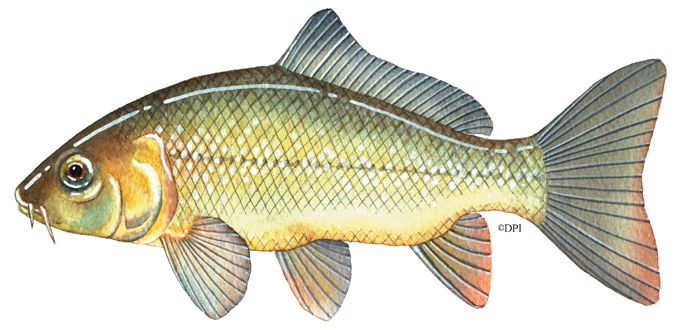Carp

| Common Name: | Carp |
| Other Name/s: | European carp, common carp, German carp, Asian carp, Chinese carp, edible carp, great carp |
| Family: | Cyprinidae |
| Scientific Name: | Cyprinus carpio (Linnaeus, 1758) |
| Origin: | Introduced |
|
Carp is a major aquatic pest species in Victoria. The classification of "introduced" reflects its translocation to Australia and Victoria, and this category is noted in the Flora and Fauna Guarantee Act 1988 (introduced to Australia after 1788 AD). Carp is listed as a "noxious aquatic species" in Victoria as declared under the Fisheries Act 1995. | |
Distribution
Widespread and common in south-eastern Victoria and waters of the Murray-Darling system. Occurs in other systems and waters in western and south-western Victoria. Extremely common in many localities, but absent east of the Snowy River.
Habitat
All types of water bodies, being able to survive a wide range of water temperatures (5-32°C), very low oxygen levels, and clear to very dirty water.
Usually most abundant in still or slow flowing water. Can survive in water quality situations too poor to support most other fish species, and can survive for several hours out of water in damp conditions.
Brief Biology
This species can grow to more than 1 m in length and exceed 60 kg in weight. In Victoria it has been recorded at 11 kg.
The carp is omnivorous and can adapt its feeding behaviour and diet to feed by a sucking action, straining bottom mud for insects and detritus, or taking insects and other food items, including small plants, from the water surface. Males mature at 2-4 years, females 3-5 years. Females produce large numbers of small eggs. There is no migration associated with spawning, which normally occurs in spring and early summer. Spawning takes place in shallow water with much surface action; this activity and splashing spreads the adhesive eggs. Young fish hatch about 5 days later. Large females may breed more than once in a season. Spawning success and growth of fish varies considerably, depending on water conditions.
Other Notes
The carp is native to Asia but it has been spread by man to all continents except Antarctica. A very active swimmer, it is able to negotiate flood flows in rivers and jump barriers up to 1 metre in height.
The majority of carp in Victorian waters are referred to as the "Boolara strain", arising from introduction of fish to Victoria in 1960 and their subsequent distribution by man. Carp have subsequently been found to travel long distances, up to 1,000 km.
Carp have been blamed as a major contributor to the decline of native fish populations in northern stream systems through their explosive spread and abundance in the late 1960's-early 1970's, but it is fair to say that this rapid expansion of carp reflected its ability to colonise suitable waters. Native fish had already suffered declines in range and abundance before the introduction of carp, largely through the impact of man on the aquatic habitat.
A major Victorian research program during the 1970's assessed means of control, and made detailed studies of carp behaviour and impact on waterways and other fishes. In summary, no means of practical control was identified, and carp were assessed generally as being a nuisance which would have to be accepted.
Other varieties
Other varieties of carp occur in Victorian waters, including:
| Leather Carp | which has few if any scales |
| Mirror Carp | which has a few, very large, mirror-like scales scattered about the body. |
| Hybrids | Carp and goldfish are known to interbreed to produce hybrid fish which generally fit the carp description. Some of these hybrids have two pairs of barbels at the mouth, but some hybrids have also been identified which have no barbels. |
Regulations
Carp is declared a noxious aquatic species in Victoria, which makes it an offence to possess, transport or release live carp, or use live carp (including all forms of carp and goldfish) as fishing bait.
The declaration of "noxious" fish does not mean that the species cannot be fished for, or eaten. Carp are widely fished for, and the flesh is enjoyed by many people, with a variety of methods of preparation and cooking.
Recreational Fishing Licence requirements and regulations affecting the taking of carp are provided in the Victorian Recreational Fishing Guide, available free from RFL sales agents and DEDJTR Offices and Information Centres.
Further Reading
- A Guide to the Freshwater Fish of Victoria, Phillip Cadwallader & Gary Backhouse, Department of Conservation and Environment.
- Australian Freshwater Fishes, John R. Merrick & Gunther E. Schmida.

